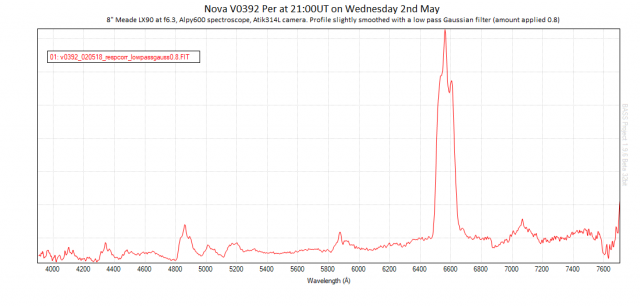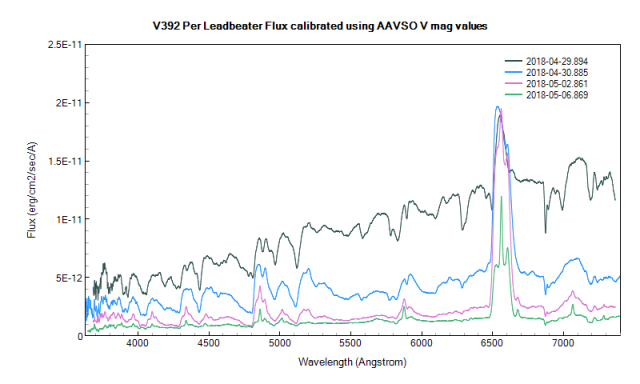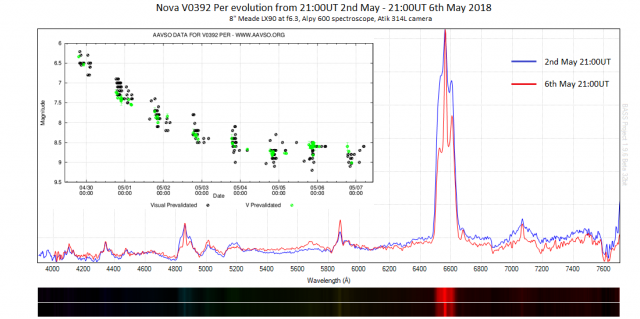› Forums › Variable Stars › Nova in Perseus
- This topic has 47 replies, 15 voices, and was last updated 7 years, 7 months ago by
 Denis Buczynski.
Denis Buczynski.
-
AuthorPosts
-
3 May 2018 at 1:14 pm #579422
 Tim HaymesParticipant
Tim HaymesParticipantI removed this comment because the picture was uploaded OK
3 May 2018 at 1:15 pm #579423 Andrew RobertsonParticipant
Andrew RobertsonParticipant🙂
3 May 2018 at 1:21 pm #579424 Jeremy ShearsParticipant
Jeremy ShearsParticipantThanks for sharing the link to Steve Shore’s explanation – it’s a really interesting read.
And congrats on getting the timely spectrum!
Go well!
Jeremy3 May 2018 at 6:47 pm #579425 Peter MulliganParticipant
Peter MulliganParticipantThe Gaia DR2 parallax puts this Binary at 12675L/y so at 6.2m its absolute magnitude rivalled Rigel for a while at -6.75M, 43,000 times the luminosity of the sun. What a view and a surprise! that would have been for any life bearing planets at 32.6 L/y or nearer!
Peter
3 May 2018 at 8:31 pm #579426 Alex PrattParticipant
Alex PrattParticipantOn Denis’ Member Page entry for May 2 a typo describes V 392 Per as a ‘comet’, so keep observing! 🙂
Clear skies,
Alex.
3 May 2018 at 11:33 pm #579427 Nick JamesParticipant
Nick JamesParticipantMike. Very nice. That H-alpha emission is very strong.
3 May 2018 at 11:37 pm #579428 Nick JamesParticipant
Nick JamesParticipantSo it does. Denis is a very dedicated comet observer not so used to imaging bright point sources that don’t move…
4 May 2018 at 4:19 pm #579430 Alex PrattParticipant
Alex PrattParticipantWe’re all likely to produce unintentional typos after a long observing session!
I used my Watec video camera and 50mm f/1.7 Vivitar SLR lens to record the field of V392 Per. I’ll add a pic to my Member Page later this weekend.
Come along to Newcastle tomorrow. My talk won’t be flawless but I hope there’s something in there of interest. 🙂
Alex.
4 May 2018 at 8:49 pm #579433 Hugh AllenParticipant
Hugh AllenParticipantNova V0392 Per on Wednesday evening 2nd May. Just had a chance to process my rather low quality spectrum taken under difficult conditions. Anyway, the hugely doppler-broadened hydrogen and helium emissions are very clear especially of course the towering Hα emission. A central, narrow peak at the normal rest wavelength is emerging from each broadened emission. This narrow peak seems to be becoming more pronounced in the most recent spectra on the ARAS forum http://spectro-aras.com/forum/viewtopic.php…
 5 May 2018 at 4:38 pm #579436
5 May 2018 at 4:38 pm #579436 Paul Anthony BrierleyParticipant
Paul Anthony BrierleyParticipantWe have a star party this evening, and thankfully the skies are clear.
I will have a look at this and report back.
6 May 2018 at 10:06 am #579437 Peter MulliganParticipant
Peter MulliganParticipantObservations for May 5 21:31 in the VSS database indicate the Nova as increased in brightness to 7.34m
Peter
6 May 2018 at 11:22 am #579439 Robin LeadbeaterParticipant
Robin LeadbeaterParticipantI suspected as much. It looked noticeably brighter in the spectrograph guider but the moment I moved it onto the slit, the mist rolled in so no spectrum last night.
Robin
EDIT: No sign of rebrightening in later data in the AAVSO database though. I am now kicking myself for not grabbing the guider image
EDIT: I see the 7.3mag in VSS was in I. My guider camera is unfiltered and the nova is very interstellar reddened so probably explains why it looked so much brighter to me than the nearby Vmag 9.3 star
6 May 2018 at 12:28 pm #579440 Gary PoynerParticipant
Gary PoynerParticipantVisual was 8.8 last night (May 5.9).
Gary
6 May 2018 at 4:37 pm #579441 Paul Anthony BrierleyParticipant
Paul Anthony BrierleyParticipantFinally, a clear sky. And a nova.
I saw V392 visually using a 24mm Panoptic in my Celestron C9.25. FOV 0.69, magnification x97. From Teggs Nose Country Park
The Nova was very easy to see next to 93 Per. I thought N392 looked reddish to my eye’s.
To confirm I had indeed found it. I compared the eyepiece view with a picture on the Sky and Telescope website.
Macclesfield AS held a public star party last night. And we were fortunate to have this nova on view. A lot of people asked the same question. What is a nova?
I was able to explain to the best of my knowledge what it was.
7 May 2018 at 12:40 am #579445 Robin LeadbeaterParticipant
Robin LeadbeaterParticipantTonight’s spectrum (in absolute flux) compared with previous spectra. Although the H alpha line remains strong in the spectrum relative to the continuum, when expressed in absolute flux the line intensity has fallen significantly over the past 4 days.
Robin
 7 May 2018 at 8:30 am #579446
7 May 2018 at 8:30 am #579446 Nick JamesParticipant
Nick JamesParticipantBrilliant work. These absolute spectra really show the evolution well.
Do you think physics will ever adopt SI units? It is one of the significant differences between physics and engineering and I have to keep looking up the scale factor between ergs and Joules. I suppose CGS is better than BTUs and feet…
7 May 2018 at 10:47 am #579447 Robin LeadbeaterParticipant
Robin LeadbeaterParticipantYes, astronomers in particular seem to be a pocket of resistance against the forces of SI.
In my other life in the paper industry, the US measure the weight per surface area of paper in pounds per ream (now generally 500 sheets) where the specified sheet size depends on the type of paper you are taking about. So 20lb newsprint (36×24 inches) is much lighter than 20lb bond paper (22×17 inches) for example !
7 May 2018 at 12:19 pm #579448 Hugh AllenParticipant
Hugh AllenParticipantRobin,
I’m not sure of the best way to compare my two relative intensity spectra but here’s what I did for my spectra from 2nd and 6th May…
Cheers
Hugh
 7 May 2018 at 3:02 pm #579450
7 May 2018 at 3:02 pm #579450 Robin LeadbeaterParticipant
Robin LeadbeaterParticipantHi Hugh,
OK so I assume your two spectra are scaled relative to the continuum over some common wavelength range? From the AAVSO data however, the V band total flux has reduced by ~0.4 mag between the two dates (I assumed values of 8.3 and 8.7) which means the amount of flux in the emission lines in the later relative flux calibrated spectrum is exaggerated. To calibrate in absolute flux I used a tool in ISIS (“Tools”, “Spectra 3” , “Flux density conversion” ) which integrates the flux in the spectrum over the standard (Bessel) V filter passband and uses the photometric V magnitude (from AAVSO) to rescale the spectrum in physical flux values. (Using the relationship between V mag and physical flux established for the standard star Vega). There are some approximations/assumptions in this method I believe and I think David Boyd has published a more rigorous method somewhere where he uses his own photometric brightness measurements but I think it should be good enough to show the trends.
Cheers
Robin
12 May 2018 at 7:13 pm #579466 Mr Jack MartinParticipant
Mr Jack MartinParticipantUnfortunately the nova appears to be too low down from my location !
Also, the SkyX doesn’t recognise the name V392 Per or its JO or SON designations. I typed in the RA and DEC coordinates instead, it seemed to track there, but was not visible through the finder scope !
Well done to everybody who got data.
Regards,
Jack
Essex UK
-
AuthorPosts
- You must be logged in to reply to this topic.
